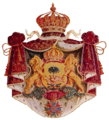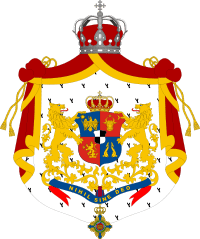Arms of dominion
Arms of Dominion are the arms borne both by a monarch and the state in a monarchy.
In this respect they are both the national arms and the arms of the nation's monarch, who is the monarchy's sovereign, and are thus simultaneously the personal arms of the monarch and the arms of the state he or she reigns over.
The arms of the monarch and the arms of the realm
The famous heraldic author John Brooke-Little, Norroy and Ulster King of Arms, in his book 'An Heraldic Alphabet' (page 38) wrote regarding Arms of Dominion:
"These, which are also styled 'arms of sovereignty', are those borne by a sovereign in respect of the territories he rules rather than his own family arms. The royal arms are arms of dominion; the Queen's arms of descent would be those of her own branch of the House of Saxony. Arms of dominion do not follow the ordinary rules and conventions of armory but are settled ad hoc by the monarch, usually, of course, with ministerial and heraldic advice."
Furthermore, in his 1983 revision to 'Boutell's Heraldry', Brooke-Little stated (page 222):
"Royal Arms, or Arms of Dominion, are inseparable from the office and rank of royalty, and cannot be borne undiffference by any person except the Sovereign...The Royal Arms may not be quartered without some difference. In the person of Sovereigns, all minor ranks and titles are merged in their royalty; consequently whatever arms they may previously have borne cease to be used at their accession, and no other arms may be quartered with the Royal Arms. The arms of the Sovereign are not impaled with those of his or her consort."
Therefore, in most hereditary monarchies the Arms of Dominion are also the Arms of State; they cannot be used by anyone else; no matter how closely related they are to the monarch. Thus younger members of Royal Houses will use arms that are similar to those of the monarch, but they are made slightly different by marks that are placed on the shield, including but not restricted to, labels. This is called cadency, and is equally applicable to the arms of non-royal families, but is not as enforced. Within royal families, however, it is rigidly enforced by the heraldic authorities of the particular country.
In republics, the arms of the head of state (who is not the sovereign by definition) are not the same as the arms of the state (which is sovereign-or rather-the people of the state are). For example, the arms of the United States of America and the arms of the various Presidents of the United States of America are not the same. This is something that has been well established since pre-modern times; the arms of the various Doges of the Republics of Republic of Venice and the Doges of the Republic of Republic of Genoa were not the same as the republics over which they ruled.
Common external elements in arms of dominion are royal pavilions, which are used in most Arms of Dominion, modern and historical, except in the arms of countries that belong to the commonwealth of nations, such pavilions being peculiar to the style of heraldry that originated in the British Isles.
Examples of Arms of Dominion currently in use

Arms of Dominion of Mohammed VI, King of Morocco 
Arms of Dominion of Tupou VI, King of Tonga 
Arms of Dominion of Albert II, Sovereign Prince of Monaco 
Arms of Dominion of Hamad bin Khalifa, Emir of Qatar 
Arms of Dominion of King Abdullah II, King of Jordan 
Arms of Dominion of Norodom Sihamoni, King of Cambodia 
Arms of Dominion (jointly) of the Co-Princes of Andorra; Emmanuel Macron and Joan Enric Vives Sicília 
Arms of Dominion of Sabah al-Ahmad, Emir of Kuwait 
Arms of Dominion of Carl XVI Gustaf, King of Sweden 
Arms of Dominion of Willem-Alexander, King of the Netherlands 
Arms of Dominion of Harald V, King of Norway 
Arms of Dominion of Mswati III, King of Swaziland 
Arms of Dominion of Henri, Grand Duke of Luxembourg 
Arms of Dominion of Prince Hans Adam II of Liechtenstein 
Arms of Dominion of King Letsie III of Lesotho 
Arms of Dominion of King Albert II of Belgium 
Arms of Dominion of Hamad, King of Bahrain 
Arms of Queen Elizabeth II of the United Kingdom (for use in England, Wales and Northern Ireland) .svg.png)
Arms of Dominion of Queen Elizabeth II of the United Kingdom (for use in Scotland)
Examples of Arms of Dominion formerly in use by monarchies that have been abolished

Arms of Dominion of Faustin I, Emperor of Haiti 
Arms of Dominion of the Kings of the Serbs, Croats and Slovenes/Yugoslavia, 1919-1945 
Arms of Dominion of the Emperors of Russia, 1857-1917 .svg.png)
Arms of Dominion of the Kings of Serbia, 1882-1918 .png)
Arms of Dominion of the Kings of the Bulgarians (there are variants) until 1946 .svg.png)
Arms of Dominion of King Victor Emmanuele III of the Albanians, 1939-1945 .svg.png)
Arms of the Kings of Italy until 1946 
Arms of the Kings of Romania from 1881 to 1922 
Arms of Dominion of the Kings of Romania, 1922-1947 
Arms of the Kings of Greece (there are variants) from 1863 to 1922 and 1935 to 1974 
Arms of the Kings of France and Navarre (there are variants) to 1792, 1814, and 1815-1830 .svg.png)
Arms of Dominion of the Emperors of the French, 1804-1814, 1815 and (with modifications), 1852-1870 
Arms of Dominion of the Shahs of Iran, 1925-1979 
Arms of Dominion of Agustin I, Emperor of Mexico, 1822-1823 
Arms of Dominion of Maximillian I, Emperor of Mexico,1863-1867 
Arms of Dominion of the Emperors of Brazil, 1822-1889 .svg.png)
Arms of Dominion of Bokassa I, Emperor of the Central African Empire 
Arms of Dominion of the Kings of Yemen until 1962 
Arms of Dominion of Idris I, King of Libya, 1951-1969 
Arms of Dominion of the Kings of Egypt, 1922-1953 
Arms of Dominion of the Kings of Iraq, 1921-1958